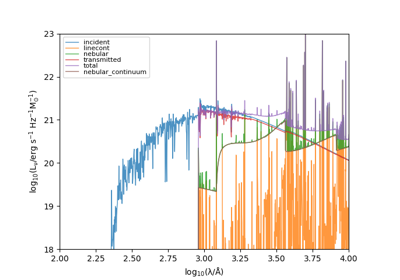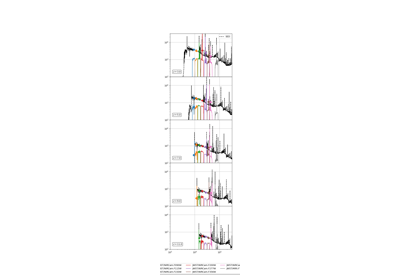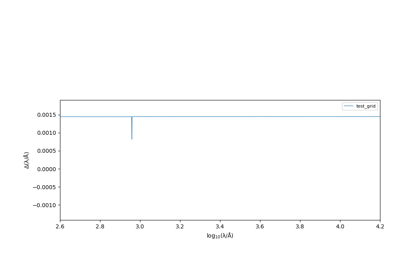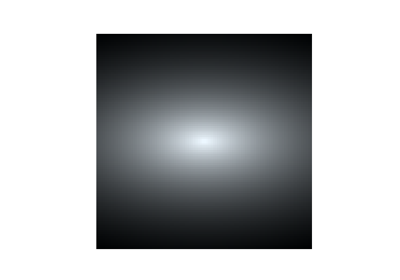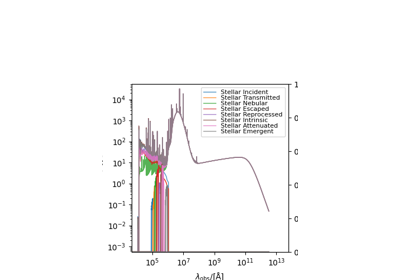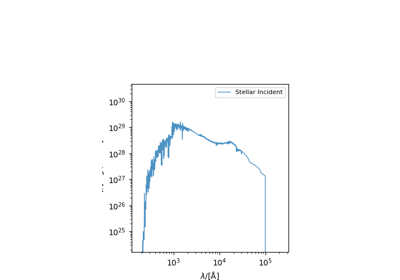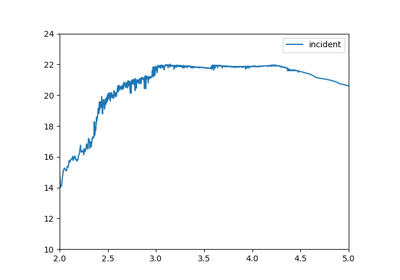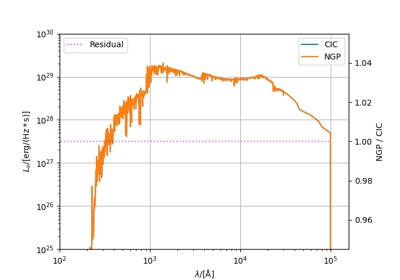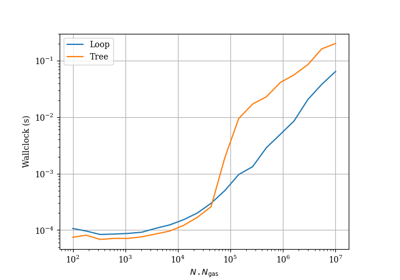synthesizer.parametric.sf_hist¶
A module for creating and manipulating star formation histories.
- NOTE: This module is imported as SFH in parametric.__init__ enabling the syntax
shown below.
Example usage:
from synthesizer.parametric import SFH
print(SFH.parametrisations)
sfh = SFH.Constant(…) sfh = SFH.Exponential(…) sfh = SFH.LogNormal(…)
sfh.calculate_sfh()
Classes
- class synthesizer.parametric.sf_hist.Common(name, **kwargs)[source]¶
The parent class for all SFH parametrisations.
- name¶
The name of this SFH. This is set by the child and encodes the type of the SFH. Possible values are defined in parametrisations above.
- Type:
string
- parameters¶
A dictionary containing the parameters of the model.
- Type:
dict
- calculate_mean_age(t_range=(0, 10000000000), dt=1000000)[source]¶
Calcualte the median age of a given star formation history.
- Parameters:
t_range (tuple, float) – The age limits over which to calculate the SFH.
dt (float) – The interval between age bins.
- Returns:
- t (array-like, float)
The age bins.
- sfh (array-like, float)
The SFH.
- calculate_median_age(t_range=(0, 10000000000), dt=1000000)[source]¶
Calculate the median age of a given star formation history.
- Parameters:
t_range (tuple, float) – The age limits over which to calculate the SFH.
dt (float) – The interval between age bins.
- Returns:
- t (array-like, float)
The age bins.
- sfh (array-like, float)
The SFH.
- calculate_sfh(t_range=(0, 10000000000), dt=1000000)[source]¶
Calculate the age of a given star formation history.
- Parameters:
t_range (tuple, float) – The age limits over which to calculate the SFH.
dt (float) – The interval between age bins.
- Returns:
- t (array-like, float)
The age bins.
- sfh (array-like, float)
The SFH in units of 1 / yr.
- get_sfr(age)[source]¶
Calculate the star formation in each bin.
- Parameters:
age (float) – The age at which to calculate the SFR.
- Returns:
- sfr (float/array-like, float)
The SFR at the passed age. Either as a single value or an array for each age in age.
Examples using synthesizer.parametric.sf_hist.Common¶
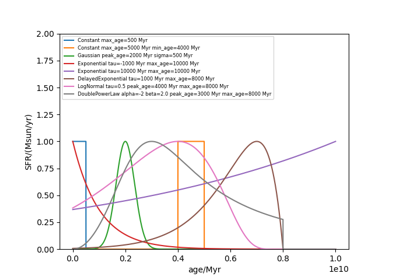
Compare different parametric star formation history models
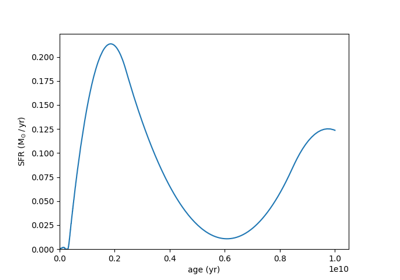
Demonstrate the dense basis approach for describing the SFZH
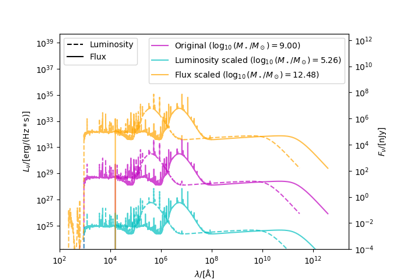
An example showing how to scale a galaxy’s mass by luminosity/flux.
- class synthesizer.parametric.sf_hist.Constant(max_age=unyt_quantity(100, 'yr'), min_age=unyt_quantity(0, 'yr'), duration=None)[source]¶
A constant star formation history.
- The SFR is defined such that:
sfr = 1; min_age<t<=max_age sfr = 0; t>max_age, t<min_age
- max_age¶
The age above which the star formation history is truncated.
- Type:
unyt_quantity
- min_age¶
The age below which the star formation history is truncated.
- Type:
unyt_quantity
Examples using synthesizer.parametric.sf_hist.Constant¶

Compare different parametric star formation history models

An example showing how to scale a galaxy’s mass by luminosity/flux.
- class synthesizer.parametric.sf_hist.DecliningExponential(tau, max_age, min_age=unyt_quantity(0., 'yr'))[source]¶
- class synthesizer.parametric.sf_hist.DelayedExponential(tau, max_age, min_age=unyt_quantity(0., 'yr'))[source]¶
A delayed exponential star formation history that can be truncated. The “delayed” element results in a more gradual increase at earlier times.
- tau¶
The “stretch” parameter of the exponential.
- Type:
unyt_quantity
- max_age¶
The age above which the star formation history is truncated.
- Type:
unyt_quantity
- min_age¶
The age below which the star formation history is truncated.
- Type:
unyt_quantity
Examples using synthesizer.parametric.sf_hist.DelayedExponential¶

Compare different parametric star formation history models
- class synthesizer.parametric.sf_hist.DenseBasis(db_tuple, redshift)[source]¶
Dense Basis representation of a SFH.
See here for more details on the Dense Basis method.
https://dense-basis.readthedocs.io/en/latest/
- db_tuple¶
Dense basis parameters describing the SFH 1) total mass formed 2) SFR at the time of observation (see redshift) 3) number of tx parameters 4) times when the galaxy formed fractions of its mass,
units of fraction of the age of the universe [0-1]
- Type:
tuple
- redshift¶
redshift at which to scale the SFH
- Type:
float
Examples using synthesizer.parametric.sf_hist.DenseBasis¶

Demonstrate the dense basis approach for describing the SFZH
- class synthesizer.parametric.sf_hist.DoublePowerLaw(peak_age, alpha, beta, min_age=unyt_quantity(0, 'yr'), max_age=unyt_quantity(1.e+11, 'yr'))[source]¶
A double power law star formation history.
- peak_age¶
The age at which the star formation history peaks.
- Type:
unyt_quantity
- alpha¶
The first power.
- Type:
float
- beta¶
The second power.
- Type:
float
- max_age¶
The age above which the star formation history is truncated.
- Type:
unyt_quantity
- min_age¶
The age below which the star formation history is truncated.
- Type:
unyt_quantity
Examples using synthesizer.parametric.sf_hist.DoublePowerLaw¶

Compare different parametric star formation history models
- class synthesizer.parametric.sf_hist.Exponential(tau, max_age, min_age=unyt_quantity(0., 'yr'))[source]¶
A exponential star formation history that can be truncated.
- Note: synthesizer uses age (not t) as its parameter such that:
t = max_age - age
- tau¶
The “stretch” parameter of the exponential.
- Type:
unyt_quantity
- max_age¶
The age above which the star formation history is truncated.
- Type:
unyt_quantity
- min_age¶
The age below which the star formation history is truncated.
- Type:
unyt_quantity
Examples using synthesizer.parametric.sf_hist.Exponential¶

Compare different parametric star formation history models
- class synthesizer.parametric.sf_hist.Gaussian(peak_age, sigma, max_age=unyt_quantity(1.e+11, 'yr'), min_age=unyt_quantity(0, 'yr'))[source]¶
A Gaussian star formation history.
- peak_age¶
The age at which the star formation peaks, i.e. the age at which the gaussian is centred.
- Type:
unyt_quantity
- sigma¶
The standard deviation of the gaussian function.
- Type:
unyt_quantity
- max_age¶
The age above which the star formation history is truncated.
- Type:
unyt_quantity
- min_age¶
The age below which the star formation history is truncated.
- Type:
unyt_quantity
Examples using synthesizer.parametric.sf_hist.Gaussian¶

Compare different parametric star formation history models
- class synthesizer.parametric.sf_hist.LogNormal(tau, peak_age, max_age, min_age=unyt_quantity(0, 'yr'))[source]¶
A log-normal star formation history.
- tau¶
The dimensionless “width” of the log normal distribution.
- Type:
float
- peak_age¶
The peak of the log normal distribution.
- Type:
float
- max_age¶
The maximum age of the log normal distribution. In addition to truncating the star formation history this is used to define the peak.
- Type:
unyt_quantity
- min_age¶
The age below which the star formation history is truncated.
- Type:
unyt_quantity
Examples using synthesizer.parametric.sf_hist.LogNormal¶

Compare different parametric star formation history models
- class synthesizer.parametric.sf_hist.TruncatedExponential(tau, max_age, min_age)[source]¶
A truncated exponential star formation history.
- tau¶
The “stretch” parameter of the exponential.
- Type:
unyt_quantity
- max_age¶
The age above which the star formation history is truncated.
- Type:
unyt_quantity
- min_age¶
The age below which the star formation history is truncated.
- Type:
unyt_quantity

